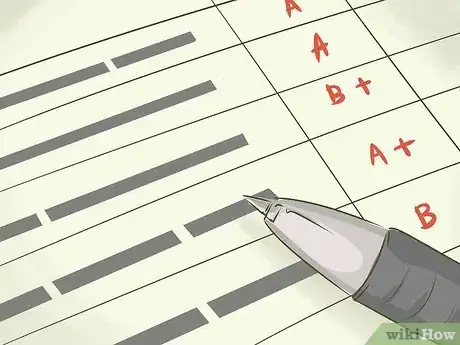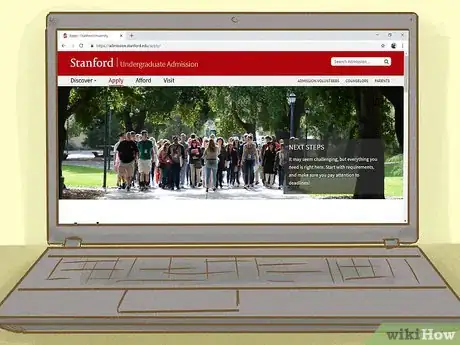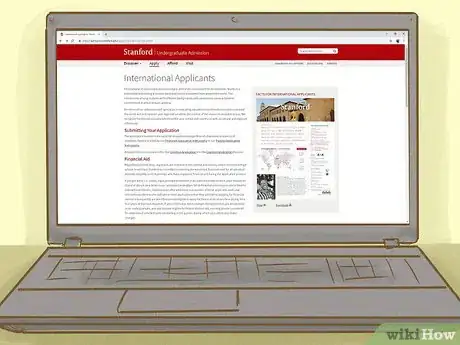This article was co-authored by Alexander Ruiz, M.Ed.. Alexander Ruiz is an Educational Consultant and the Educational Director of Link Educational Institute, a tutoring business based in Claremont, California that provides customizable educational plans, subject and test prep tutoring, and college application consulting. With over a decade and a half of experience in the education industry, Alexander coaches students to increase their self-awareness and emotional intelligence while achieving skills and the goal of achieving skills and higher education. He holds a BA in Psychology from Florida International University and an MA in Education from Georgia Southern University.
wikiHow marks an article as reader-approved once it receives enough positive feedback. In this case, several readers have written to tell us that this article was helpful to them, earning it our reader-approved status.
This article has been viewed 426,508 times.
Choosing a college can be a very stressful time, especially when you're aiming for one of the absolute best schools in the US. Stanford is a "holistic" school with no minimum GPA, class rank, or standardized test score requirements. While they accepted a grand total of 5% of all applicants last year, it's still possible.[1] We'll outline the process of becoming a Cardinal. Read on.
Steps
Being an Exceptional Student
-
1Start ASAP. The fact of the matter is that kids are growing up faster and faster nowadays and parents are becoming more and more demanding. Stanford is one of the most selective universities in the US. Taking an AP class in high school isn't nearly as impressive when your neighbor is taking it as a 12-year-old. The sooner you start being an amazing student, the better! In other words, start in junior high if you can.
- You know the phrase "You can't teach an old dog new tricks?" Take it to heart. Picking up a sport, a language, a hobby, or a skill is infinitely harder the older you get. Do yourself a favor now and get involved in whatever you can. By the time you need to apply, you'll be the cream of the crop.
-
2Get on the right academic track in high school. Meet with your high school counselor regularly from day one to review your academic progress. Inform them you're looking to go to Stanford so they can get you on the right track as soon as possible. They'll be able to suggest classes and tell you what you need to do to get started.
- Keep your career goals in mind when it comes to choosing classes. For example, becoming a doctor would require Algebra 1, 2, Geometry, Calculus, Trigonometry, and any other math classes you have offered in your school along with Physics, Chemistry, and any other science classes you have. For art/design careers, physics, geometry, art, and computer design are wonderful.
- Be aware that Stanford recommends 4 years of English with an emphasis on writing and literature; 4 years of Mathematics with emphasis on algebra, trigonometry and geometry; 3 years of History/Social Studies, preferably with an essay component; and 3 years of laboratory science, such as biology, chemistry and physics. Three-to-four years of a foreign language is also recommended.
Advertisement -
3Get outrageously stellar grades. The better your grades, the better your chances, even though Stanford has no "minimum GPA" requirement. And if your grades are in AP and advanced classes, even better. 56% of all applicants have a GPA of 4.0 or better.[2]
- That being said, you can get into this school with a less than perfect GPA. If you have a 3.5 but you invented a school curriculum that 10 states have adopted, you'll still get in. You just may end up going to MIT instead![3]
- To maintain a high GPA, you have to maintain good activities and good extracurriculars. Also, it is important to have good relationships with your counselors and teachers.
-
4Enroll yourself in AP classes. You should begin as early as possible taking gifted classes and any honors classes that your school offers. Yes, you will have to take EOC tests for those classes, but the more the merrier! If your school only offers a few, take them.
- This is important because Stanford weighs certain classes against others. The more AP classes you have -- and if you get good grades in them -- the more impressive your application will be. Harder classes are given more consideration.
-
5Think quality versus quantity when it comes to extracurricular activities. The university is looking for enthusiasm and commitment in what you're doing. That might be better shown as in-depth experience in a couple of activities rather than minimal participation in many clubs and sports. Find what you enjoy and do it. Do it throughout your high school career.
- No extracurricular activity has more merit than another at this college. As long as you can prove you're sticking with it and advancing, it's impressive.
- Participate in clubs that your school has, like Student Council, Spirit, Debate, or NHS. Run for class president and be one of the officers. Participate in a school play. Start an environment group. Be as well-rounded as possible.
-
6Volunteer. If there's something during your time in high school you should make time for, it's volunteering. Not only do you have to be smart, athletic, and well-spoken, you have to be kind and community-oriented, too. A good GPA isn't that hard to come by -- but a person with good character, solid morals, and a good GPA takes the cake.
- Look into volunteering at your local hospital, animal shelter, homeless shelter, nursing home, daycare, or with larger groups like Habitat for Humanity. If you're interested in an organization doesn't have an established volunteer program, ask! Very few people turn down those willing to work for free.
-
7Rock the ACT plus Writing or SAT test. One of these standardized tests is REQUIRED by Stanford in order to be considered. However, there's no minimal test score needed in order to be admitted. Although, getting a near perfect score will rocket your chances into getting into Stanford. In the last year, 25% of the admitted class received an 800 on their SAT for both math and critical thinking.[4]
- Two SAT subject tests are recommended, but are not required. You will need to include official results if you choose to submit these tests. Take reading and math, as this is pretty much the bare minimum of the two tests. Take writing if possible. Go on websites like number2.com in middle school so you will get a perfect score in high school!
- If your results are less than you were hoping for, don't let it keep you from applying. There are a dozen other things being considered in addition to your test scores.
-
8Do something extraordinary. If it's not easily explicable, even better. Consider student A: She's captain of the volleyball team, the lead in the school play, has a 4.0 GPA, volunteers at a domestic abuse shelter for women, is a black belt in karate, and speaks fluent Japanese and Tagalog. Impressive stuff. Student B just went on a UN trip to Switzerland and coordinated delegates. Wait, what?
- Both students A and B did things that were very impressive and required hard work -- no one's going to argue otherwise. However, student A did things that most people could see themselves or someone they know doing. As for student B -- how they heck did they get involved with the UN at 17?! They must have something special about them. Even though student B got lucky, attended a conference and just schmoozed the right people, no one knows that. They just know that student B did something incredible. Something they can't explain. And that's impressive. Stanford loves impressive.[5]
Mastering the Application Process
-
1Know the deadlines. The Restrictive Early Action deadline is November 1st. The regular decision deadline is January 1st. If you are including an arts supplement, the deadlines are October 15th and December 1st, respectively. Most students abide by the regular decision guidelines.
- "Restrictive Early Action" should only be used if you are confident Stanford is your first choice. Conduct a thorough search of other colleges before you assume this is the action you should take.
- Visit admission.stanford.edu/arts for information on submitting the arts supplement. If you are serious about the arts and intend on pursuing them in some form (no commitment to pursuing them at Stanford is necessary), consider this section of the application and its respective deadlines.
-
2Go to Stanford's application website. For the most up-to-date information, that's where you'll want to be. Click on the "never registered" link under "Apply" in the middle of the screen. And you're off!
- You must apply online unless you have special circumstances that prevent you from doing so. Stanford University only accepts online applications unless you are given special permission to send in paper applications.
-
3Fill out the "First Year Common Application" and "The Stanford Supplement" forms and submit both of them. The process will be very linear and straightforward online -- you can find them at commonapp.org.
- Your high school transcripts are also required. Your school has the choice of sending them electronically or by mail. There are three forms that must be completed: the Secondary School Report, the Mid-Year School Report and the Final Report. These forms can be completed or downloaded at the Common Application Web Site.
- You must also send in a $90 non-refundable application fee with these forms. If you'd like to have the fee waived, talk to your counselor and fill out the necessary form online or fax it to (650) 723-6050.
-
4Obtain 2 teacher evaluations. These evaluations must come from teachers who taught you in grades 11 or 12, unless you took advanced level courses in grade 10. Be sure to ask well in advance -- some teachers will take their sweet, sweet time when it comes to recommendation letters and evaluations. Your teachers should submit them online, as per Stanford's preferences.
- These evaluations must come from 2 different core subjects. Examples of accepted subjects include Math, English, Science, Foreign Languages or History/Social Sciences.
- You may take the option of including a third letter not from a teacher, if you feel it would round out the impression you give of yourself. However, this is optional and a third letter will neither increase or decrease your chances.
-
5Dominate the essay. Be yourself when writing your essays for Stanford. The college is looking for your "genuine" voice and not what you think they want, also known as "packaging." The committee has seen it all, can easily call BS, and won't be impressed by anything other than innovation, genuineness, and honesty.
- It is possible to write an essay on your love of ice cream and get in.[6] Don't think you have to write your standard "Look at how awesome I am" essay -- at least directly. If you show you have drive, commitment, and are willing to step out of the box, you stand a decent chance of getting in.
-
6Don't resort to using gimmicks. Rest assured that the acceptance committee doesn't fall for much. They've seen tie-dyed boxers, dozens and dozens of baked goods, and even planes flying overhead trying to get students in.[7] Know that they don't work. Only "you" seals the deal, not the gimmicks you employ.
-
7Be realistic. Each year, Stanford accepts fewer and fewer students -- well, really, more and more are applying (around 20,000).[8] Last year, they accepted around 7% of all applicants.[9] Even if you're Mr or Ms. Diamond Child Extraordinaire, you may not get in. And that's fine! It's not reflective of worth. Plenty of other schools will get you on the path to success, too.
- You should always, always have safety schools up your sleeve. If Stanford doesn't work out, you need a backup plan. If they accept you it doesn't mean you have to go!
-
8Know that Stanford is need-blind. This means that whether you're the son of Bill Gates or the daughter of an unemployed illegal immigrant, you'll be given consideration. What's more, Stanford has great financial aid -- if you don't think you can afford it, apply anyway.
- Yep, Stanford is a very, very expensive school to attend. You're looking at over $13,000 a quarter.[10] But again, don't write it off. Stanford knows it's expensive -- it wants to help you out. It doesn't care whether you're the best of the best -- if you need aid, you will receive it.
- Apply for the CSS PROFILE (College Scholarship Service) and FAFSA (Free Application for Federal Student Aid) online. It'll take about 20 minutes and should be done by January.[11]
Attending Stanford as a Transfer or International Student
-
1Meet the deadlines. For transfer students, the deadlines are a bit different. The application with the Arts supplement deadline and the standard application is March 15th; however, the SAT must be taken by January and the ACT by February. This goes for transferring students, whether you're international or not.
- Traditional students abide by an earlier timeline -- they apply by January. They'll also get notified by April, whereas you'll get notified by May.
-
2Check that you meet Stanford's eligibility requirements for a transfer admission. Consult the Stanford Bulletin and the registrar's web page for the most updated information on what transfer credits are accepted. If you have any questions, your adviser can help you out.
- Only classes in which you obtained a C- or higher will be counted toward your degree. What's more, only coursework from accredited universities that is similar to what Stanford offers will be accepted for credit.[12]
- In order to obtain a degree from Stanford, you need to complete at least two years of coursework at the university. [13]
-
3Complete the Common Application's Transfer Application and the Stanford Supplement. Both of these must be completed and submitted online at the Common Application Web Site. Also complete the Transfer Application Personal Essay as well as the Stanford Supplement Short Essays. Essay tips can be found in the "Mastering the Application Process" of this article.
- The process for you is very similar to process traditional students undertake. Instead of just high school transcripts, you'll be offering up your college ones, too. The same fees apply.[14]
-
4Obtain two instructor evaluations. These evaluations must be from an academic teacher at your college, unless you have only taken large lecture courses. In those cases, a teaching assistant can fill out the form.
- Just as with the traditional students, you may submit an optional third letter from someone other than a teacher who knows you well and can round out your character. It will neither increase or decrease your chances.[15]
- Have your instructors submit them online, if at all possible. Stanford is trying its hardest to go paperless and highly prefers online submission.
-
5For international students, submit the International Supplement form. This is an addition to the forms outlined in the traditional student section. Other than that, the process and expectations are no different.
- Translation of official transcripts and teacher evaluations into English is required. Original copies of your instructions should also be translated. These translations should be by teachers or school administrators who know English well.
- You can also take the Test of English as a Foreign Language (TOEFL) if you are not a native English speaker. The test is not required, but is recommended.
-
6Reply to Stanford by June 1st. If you get notified that you were accepted, well, for starters, congratulations! Secondly, let them know by June 1st of your decision. The sooner you do, the sooner you can get started on living arrangements and financial aid.
- If you don't get in, don't stress. Getting in as a transfer student is even more difficult statistically than getting in as a traditional student -- in recent years, somewhere between 1 and 4% of transfer applicants get accepted. That's because only 20 to 50 spots are open annually. If you don't get in, you're in good company.
Expert Q&A
-
QuestionAre AP courses important for Stanford?
 Alexander Ruiz, M.Ed.Alexander Ruiz is an Educational Consultant and the Educational Director of Link Educational Institute, a tutoring business based in Claremont, California that provides customizable educational plans, subject and test prep tutoring, and college application consulting. With over a decade and a half of experience in the education industry, Alexander coaches students to increase their self-awareness and emotional intelligence while achieving skills and the goal of achieving skills and higher education. He holds a BA in Psychology from Florida International University and an MA in Education from Georgia Southern University.
Alexander Ruiz, M.Ed.Alexander Ruiz is an Educational Consultant and the Educational Director of Link Educational Institute, a tutoring business based in Claremont, California that provides customizable educational plans, subject and test prep tutoring, and college application consulting. With over a decade and a half of experience in the education industry, Alexander coaches students to increase their self-awareness and emotional intelligence while achieving skills and the goal of achieving skills and higher education. He holds a BA in Psychology from Florida International University and an MA in Education from Georgia Southern University.
Educational Consultant Definitely! Applying to Stanford requires a high level of academic rigor. AP classes are very high level and raise your GPA—that weighted GPA can be submitted to Stanford during the application process, which will show a higher level of rigor than an "average student."
Definitely! Applying to Stanford requires a high level of academic rigor. AP classes are very high level and raise your GPA—that weighted GPA can be submitted to Stanford during the application process, which will show a higher level of rigor than an "average student." -
QuestionWhat type of students does Stanford look for?
 Alexander Ruiz, M.Ed.Alexander Ruiz is an Educational Consultant and the Educational Director of Link Educational Institute, a tutoring business based in Claremont, California that provides customizable educational plans, subject and test prep tutoring, and college application consulting. With over a decade and a half of experience in the education industry, Alexander coaches students to increase their self-awareness and emotional intelligence while achieving skills and the goal of achieving skills and higher education. He holds a BA in Psychology from Florida International University and an MA in Education from Georgia Southern University.
Alexander Ruiz, M.Ed.Alexander Ruiz is an Educational Consultant and the Educational Director of Link Educational Institute, a tutoring business based in Claremont, California that provides customizable educational plans, subject and test prep tutoring, and college application consulting. With over a decade and a half of experience in the education industry, Alexander coaches students to increase their self-awareness and emotional intelligence while achieving skills and the goal of achieving skills and higher education. He holds a BA in Psychology from Florida International University and an MA in Education from Georgia Southern University.
Educational Consultant Stanford looks for students who act like Stanford students already. This means having a Stanford-level GPA , as well as exploring your academic interests and passions to the nth degree. With this attitude, you can be a "Stanford student" even when you're in middle school.
Stanford looks for students who act like Stanford students already. This means having a Stanford-level GPA , as well as exploring your academic interests and passions to the nth degree. With this attitude, you can be a "Stanford student" even when you're in middle school. -
QuestionCan I still get into Stanford if I volunteer, have good grades, and have been doing a number of extracurriculars for many years, but I'm not talented at sports?
 Community AnswerYes, definitely!! Unless you want to pursue a career in sports, not being good at sports will not hinder your chance at getting in. Remember, they focus on academics more.
Community AnswerYes, definitely!! Unless you want to pursue a career in sports, not being good at sports will not hinder your chance at getting in. Remember, they focus on academics more.
References
- ↑ 1.01.11.2http://www.stanford.edu/dept/uga/basics/selection/profile.html
- ↑ 5.05.1http://calnewport.com/blog/2010/03/26/how-to-get-into-stanford-with-bs-on-your-transcript-failed-simulations-the-surprising-psychology-of-impressiveness/
- ↑ http://gawker.com/these-personal-essays-will-get-you-into-stanford-479621420
- ↑ http://alumni.stanford.edu/get/page/magazine/article/?article_id=41432
- ↑ http://alumni.stanford.edu/get/page/magazine/article/?article_id=41432
- ↑ http://feross.org/how-to-get-accepted-at-stanford/
- ↑ http://www.stanford.edu/dept/registrar/bulletin1112/4835.htm
- ↑ http://www.fafsa.ed.gov
- ↑ 13.013.1https://admission.stanford.edu/apply/transfer/credit.html
About This Article
To get into Stanford, start by taking high school classes that coincide with your intended area of study. AP classes are even more impressive, as long as you can still get good grades in them. Aside from school, focus on one or two extracurriculars or volunteer opportunities that you’re passionate about. Additionally, consider taking a prep course for standardized tests, because perfect scores will give you a better chance of being admitted. For tips on how to submit an impressive application to Stanford, read on!
























-Step-11.webp)

















-Step-11.webp)



































